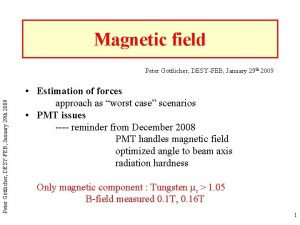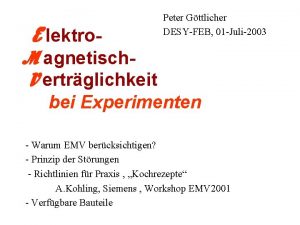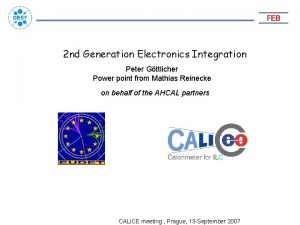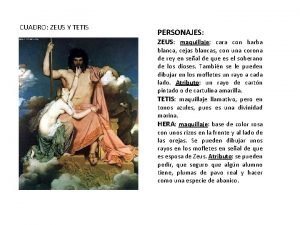The ZEUS HadronElectronSeparator Performance and Experience Peter Gttlicher
















- Slides: 16

The ZEUS Hadron-Electron-Separator Performance and Experience Peter Göttlicher (DESY) for the ZEUS-HES-group Contributions to HES Germany, Israel, Japan, Korea, Russia, Spain, USA Outline: l Introduction l Experimental set-up l Performance and experience l Summary

ZEUS and HERA Central part of the ZEUS detector HERA Front side of the FCAL Radius 1. 9 m HERA e± 27. 5 Ge. V Proton 820/920 Ge. V HES e±, g : Ge. V to 100 Ge. V à Good separation of e± , g from hadrons in particular inside jets à Detector at shower maximum: called HES: Planes inside calorimeter Electromagnetic cell 5× 20 cm 2

Principle of HES Use: e±, g early and narrow shower Hadron Electron Separator Electromagnetic Calorimeter (26 X 0, 1 l. Nuclear) Strategy: Measure deposit of energy of particles at given longitudinal position Detector: Plane at 3 -5 X 0 (maximum of intensity) Segmentation helps : e±, g in jets

Constraints Low impact to energy measurement HES is at most sensitive position à Small depth: 1. 4 cm à Low absorption à Material Magnetic field Geometry: Gap surrounded by calorimeter parts à Access only from top 16. 3× 1. 4 cm 2 for -- 672 channels -- signals, power, cooling

Experimental Set-up Diode as Active Part Advantage: High charge in small space 400 mm, 33000 e-h-pairs/particle Active area : 3. 32× 2. 96 cm 2 Compatible to shower size RMolière= 2 cm Calorimeter cell 5× 20 cm 2 à HES consists: 20518 diodes or 20 m 2 silicon

Connectors Multilayer Board as central part of the mechanics à à 2 Functions: Mechanical stability à Cable: 112 channels + support lines à Parameters: à 18 Layers à Unusual: 4. 6 m long with special production à Effect on electrical signal by small signal line: C 1 n. F à rise time: 50 ns to 100 ns (HERA: 96 ns/bunch)

Construction of a Module cut Full coverage with Si-diodes Shifting and folding 2 boards Diodeó opposite preamplifier à Diodes+electronics encapsulated Thickness = 0. 1 X 0 Cooling needed: Low power = 90 m. W/channel but l low heat conductivity of surrounding calorimeter l 4. 6 m long gap

Performance: Coverage à Cover full plane , no overlaps Reached by HES: 85 % of whole active 94% of accessible area Remaining gaps: -- Calorimeters wavelength shifter 9. 5% -- Diodes side by side Field stop ring 2. 5% -- Mechanics 2. 5% -- 4 diodes on one 4”-wafer (cost) 0. 5%

Electronics Rise time 2 HERA cycles (180 ns) à independent from multilayer board à tolerable for low rate at ZEUS

Performance and Experience Calibration Muons in situ: l Minimum ionising particle l 1 MIP= Energy deposition of 120 ke. V Electronic calibration: l Charge injection to preamplifier l Only weekly performed Low drifts Mainly as check for faults

Clustering Cluster Algorithm: • Take diode with highest signal • Associate 8 neighbours à On Average: 96% of energy contained in cluster

Position reconstruction e±, g Algorithm: x = S ( w(Energy ) · x ) à à Cluster i Diode i Result: l Test beam with 25 Ge. V electrons: 85% center of modules, away from edges 5. 4 mm l ZEUS, From Monte-Carlo, DIS (~25 Ge. V) 5 mm

Electrons and Hadrons Test beam: Known particle identity à Well separation electron/hadron but some electrons have no shower and some hadrons showered Cut: 90% efficiency for electrons:

Running Performance Installation RHES 1992 -1994 FHES 1996 -1998 Bad channels 3 -6% 2 -3% Source for failures: l Mainly connectors l 100 channels/month single electronic cards ÄContinuously repaired l Water leak 1999 -2000

Major Problem: Water Leak What? Tubes inside the gap corroded from inside to outside When? After 6 to 8 years of running Involved parts: l Copper-tubes 3 mm diameter, 0. 3 mm wall thickness l De-ionised water, sulphur (SO 42 -) and carbon found Actions: l l l Complete exchange of cooling pipes Purification of tubes from oil Replacing long rubber tubes by copper Ion exchanger installed Continuous monitoring à Ready for new data taking

Summary Hadron-Electron-Separator a shower maximum counter at ZEUS l 20 m 2 of silicon, 20518 diodes pulse height readout 94% coverage l Running since 1992 Reasonable rate of faults , Repaired in access days and maintenance periods l Signals from muons, electrons and hadrons Improvements: Factor 5 for hadron rejection Factor 2 for the position resolution Factor 10 in granularity l Continuous use to check the e-finders Efficiency without redundancy is a problem
 Direct and indirect experience examples
Direct and indirect experience examples Imprint definition psychology
Imprint definition psychology Continuity vs discontinuity
Continuity vs discontinuity Hát kết hợp bộ gõ cơ thể
Hát kết hợp bộ gõ cơ thể Slidetodoc
Slidetodoc Bổ thể
Bổ thể Tỉ lệ cơ thể trẻ em
Tỉ lệ cơ thể trẻ em Gấu đi như thế nào
Gấu đi như thế nào Thang điểm glasgow
Thang điểm glasgow Alleluia hat len nguoi oi
Alleluia hat len nguoi oi Môn thể thao bắt đầu bằng từ đua
Môn thể thao bắt đầu bằng từ đua Thế nào là hệ số cao nhất
Thế nào là hệ số cao nhất Các châu lục và đại dương trên thế giới
Các châu lục và đại dương trên thế giới Công thức tiính động năng
Công thức tiính động năng Trời xanh đây là của chúng ta thể thơ
Trời xanh đây là của chúng ta thể thơ Mật thư anh em như thể tay chân
Mật thư anh em như thể tay chân Làm thế nào để 102-1=99
Làm thế nào để 102-1=99































